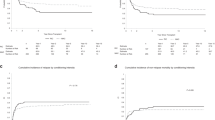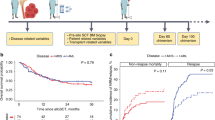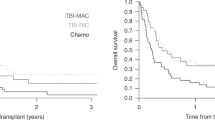Summary:
The impact of disease burden on the outcome of patients with acute myeloid leukemia (AML) undergoing allogeneic stem cell transplantation (SCT) has not been well defined. Data from several retrospective series suggest that overt leukemia at the time of transplant increases the risk of relapse. We reviewed the outcomes of 68 consecutive adults with AML (n=60) or myelodysplastic syndromes (MDS) (n=8) who received an allogeneic SCT at the University of Chicago between May 1986 and October 2002 to confirm the importance of currently recognized risk factors for overall survival (OS) and progression-free survival (PFS). In addition, we wanted to determine whether quantification of residual disease by blast percentage or cytogenetic abnormalities at the time of SCT was correlated with outcome. AML subtypes based on the FAB classification were as follows: M0=9, M1=9, M2=16, M3=2, M4=16, M5=3, M6=5. Cytogenetic analysis was available from 52 patients. Using standard morphologic criteria, 34 patients were in complete remission (CR) and 34 had visible leukemia present. The majority of donors were HLA-identical siblings (n=55). In all, 56 patients received myeloablative conditioning regimens and 12 received a reduced-intensity, fludarabine-based conditioning regimen. OS and PFS times were 7.1 months (95% CI, 4.8–10.4) and 5.1 months (95% CI, 3.2–7.8), respectively. Median follow-up from SCT was 4.6 years (range, 0.6–17.0) for survivors. In multivariate analysis, the following factors were found to be associated with worse survival: (1) increased percentage of blasts in the bone marrow at the time of SCT, (2) presence of acute graft-versus-host disease, (3) mismatched donor, (4) Zubrod performance score of ⩾2, and (5) age ⩾45 years. We also found a trend towards improved outcome among patients in cytogenetic remission as compared to those who had residual cytogenetic abnormalities and those in overt relapse. These data support an association between pre-transplant disease burden and poor outcome after SCT.
This is a preview of subscription content, access via your institution
Access options
Subscribe to this journal
Receive 12 print issues and online access
$259.00 per year
only $21.58 per issue
Buy this article
- Purchase on Springer Link
- Instant access to full article PDF
Prices may be subject to local taxes which are calculated during checkout


Similar content being viewed by others
References
Champlin R, Gale RP . Acute myelogenous leukemia: recent advances in therapy. Blood 1987; 69: 1551–1562.
Lowenberg B, Downing JR, Burnett A . Acute myeloid leukemia. N Engl J Med 1999; 341: 1051–1062.
Sierra J, Storer B, Hansen JA et al. Unrelated donor marrow transplantation for acute myeloid leukemia: an update of the Seattle experience. Bone Marrow Transplant 2000; 26: 397–404.
Burnett AK, Goldstone AH, Stevens RF et al. The Role of BMT in Addition to Intensive Chemotherapy in AML in First CR: Results of the MRC AML-10 Trial. San Diego, CA: American Society of Hematology, 1994, p 252a.
Ferrant A, Doyen C, Delannoy A et al. Karyotype in acute myeloblastic leukemia: prognostic significance in a prospective study assessing bone marrow transplantation in first remission. Bone Marrow Transplant 1995; 15: 685–690.
Ferrant A, Labopin M, Frassoni F et al. Karyotype in acute myeloblastic leukemia: prognostic significance for bone marrow transplantation in first remission: a European Group for Blood and Marrow Transplantation study. Acute Leukemia Working Party of the European Group for Blood and Marrow Transplantation (EBMT). Blood 1997; 90: 2931–2938.
Gale RP, Horowitz MM, Weiner RS et al. Impact of cytogenetic abnormalities on outcome of bone marrow transplants in acute myelogenous leukemia in first remission. Bone Marrow Transplant 1995; 16: 203–208.
Greinix HT, Nachbaur D, Krieger O et al. Factors affecting long-term outcome after allogeneic haematopoietic stem cell transplantation for acute myelogenous leukaemia: a retrospective study of 172 adult patients reported to the Austrian Stem Cell Transplantation Registry. Br J Haematol 2002; 117: 914–923.
Byrd JC, Mrozek K, Dodge RK et al. Pretreatment cytogenetic abnormalities are predictive of induction success, cumulative incidence of relapse, and overall survival in adult patients with de novo acute myeloid leukemia: results from Cancer and Leukemia Group B (CALGB 8461). Blood 2002; 100: 4325–4336.
Slovak ML, Kopecky KJ, Cassileth PA et al. Karyotypic analysis predicts outcome of preremission and postremission therapy in adult acute myeloid leukemia: a Southwest Oncology Group/Eastern Cooperative Oncology Group Study. Blood 2000; 96: 4075–4083.
Visani G, Bernasconi P, Boni M et al. The prognostic value of cytogenetics is reinforced by the kind of induction/consolidation therapy in influencing the outcome of acute myeloid leukemia – analysis of 848 patients. Leukemia 2001; 15: 903–909.
Grimwade D, Walker H, Oliver F et al. The importance of diagnostic cytogenetics on outcome in AML: analysis of 1612 patients entered into the MRC AML 10 trial. The Medical Research Council Adult and Children's Leukaemia Working Parties. Blood 1998; 92: 2322–2333.
Przepiorka D, Weisdorf D, Martin P et al. 1994 Consensus Conference on acute GVHD grading. Bone Marrow Transplant 1995; 15: 825–828.
Sullivan KM, Shulman HM, Storb R et al. Chronic graft-versus-host disease in 52 patients: adverse natural course and successful treatment with combination immunosuppression. Blood 1981; 57: 267–276.
Kaplan E . Nonparametric estimation for incomplete observations. J Am Statist Assoc 1958; 53: 457–481.
Cox D . Regression models and life tables. J Roy Statist Soc B 1972; 34: 187–220.
van Besien K, Smith S, Detenike O et al. Alemtuzumab (Campath) based GVHD Prophylaxis Leads to Improved Survival after Allogeneic Transplantation for Patients with Advanced Hematologic Malignancies. San Diego, CA: American Society of Hematology, 2003.
Clift RA, Buckner CD, Thomas ED et al. The treatment of acute non-lymphoblastic leukemia by allogeneic marrow transplantation. Bone Marrow Transplant 1987; 2: 243–258.
Clift RA, Buckner CD, Appelbaum FR et al. Allogeneic marrow transplantation during untreated first relapse of acute myeloid leukemia. J Clin Oncol 1992; 10: 1723–1729.
Appelbaum FR, Clift RA, Buckner CD et al. Allogeneic marrow transplantation for acute nonlymphoblastic leukemia after first relapse. Blood 1983; 61: 949–953.
Horowitz MM, Rowlings PA . An update from the International Bone Marrow Transplant Registry and the Autologous Blood and Marrow Transplant Registry on current activity in hematopoietic stem cell transplantation. Curr Opin Hematol 1997; 4: 395–400.
Venditti A, Maurillo L, Buccisano F et al. Pretransplant minimal residual disease level predicts clinical outcome in patients with acute myeloid leukemia receiving high-dose chemotherapy and autologous stem cell transplantation. Leukemia 2003; 17: 2178–2182.
Wolfgang Kern MS, Schmid C, Schoch C et al. Allogeneic Stem Cell Transplantation Immediately After Cytoreductive Chemotherapy or After Achievement of Complete Remission in Patients with Refractory and Relapsed Acute Myeloid Leukemia: Cytogenetically Stratified Matched-Pair Analysis of 125 Patients. Session Type: Oral Session. San Diego, CA: American Society of Hematology, 2003.
Markus Andreas Schaich MF, Bornhaeuser M, Thiede C et al. Rapid Risk-Profiling Including Fast Donor Search within a Multi-Center Trial Allows for Early Allogeneic Stem Cell Transplantation during Aplasia in Patients with High-Risk Acute Myeloid Leukemia. San Diego, CA: American Society of Hematology, 2004.
Venditti A, Buccisano F, Del Poeta G et al. Level of minimal residual disease after consolidation therapy predicts outcome in acute myeloid leukemia. Blood 2000; 96: 3948–3952.
Venditti A, Maurillo L, Buccisano F et al. Pretransplant minimal residual disease level predicts clinical outcome in patients with acute myeloid leukemia receiving high-dose chemotherapy and autologous stem cell transplantation. Leukemia 2003; 17: 2178–2182.
Copelan EA, Penza SL, Elder PJ et al. Analysis of prognostic factors for allogeneic marrow transplantation following busulfan and cyclophosphamide in myelodysplastic syndrome and after leukemic transformation. Bone Marrow Transplant 2000; 25: 1219–1222.
Frassoni F, Labopin M, Powles R et al. Effect of centre on outcome of bone-marrow transplantation for acute myeloid leukaemia. Acute Leukaemia Working Party of the European Group for Blood and Marrow Transplantation. Lancet 2000; 355: 1393–1398.
Daniel A, Pollyea ASA, Stock W et al. Clinical Predictors of Transplant Related Mortality after Reduced Intensity Allogeneic Stem Cell Transplantation (RIST). San Diego, CA: American Society of Hematology, 2004.
Mohamed Sorror MM, Baron F, Sandmaier B et al. A Modified Hematopoietic Cell Transplantation (HCT)-Specific-Comorbidity Index. San Diego, CA: American Society of Hematology, 2004.
Author information
Authors and Affiliations
Corresponding author
Rights and permissions
About this article
Cite this article
Kebriaei, P., Kline, J., Stock, W. et al. Impact of disease burden at time of allogeneic stem cell transplantation in adults with acute myeloid leukemia and myelodysplastic syndromes. Bone Marrow Transplant 35, 965–970 (2005). https://doi.org/10.1038/sj.bmt.1704938
Received:
Accepted:
Published:
Issue Date:
DOI: https://doi.org/10.1038/sj.bmt.1704938
Keywords
This article is cited by
-
Impact of disease burden on clinical outcomes of AML patients receiving allogeneic hematopoietic cell transplantation: a study from the Acute Leukemia Working Party of the European Society for Blood and Marrow Transplantation
Bone Marrow Transplantation (2023)
-
Comparison of minimal residual disease as outcome predictor for AML patients in first complete remission undergoing myeloablative or nonmyeloablative allogeneic hematopoietic cell transplantation
Leukemia (2015)
-
Achieving stringent CR is essential before reduced-intensity conditioning allogeneic hematopoietic cell transplantation in AML
Bone Marrow Transplantation (2013)
-
A novel clofarabine bridge strategy facilitates allogeneic transplantation in patients with relapsed/refractory leukemia and high-risk myelodysplastic syndromes
Bone Marrow Transplantation (2013)
-
Prognostic and therapeutic implications of minimal residual disease at the time of transplantation in acute leukemia
Bone Marrow Transplantation (2013)



